2009 CHEVROLET IMPALA window
[x] Cancel search: windowPage 254 of 406
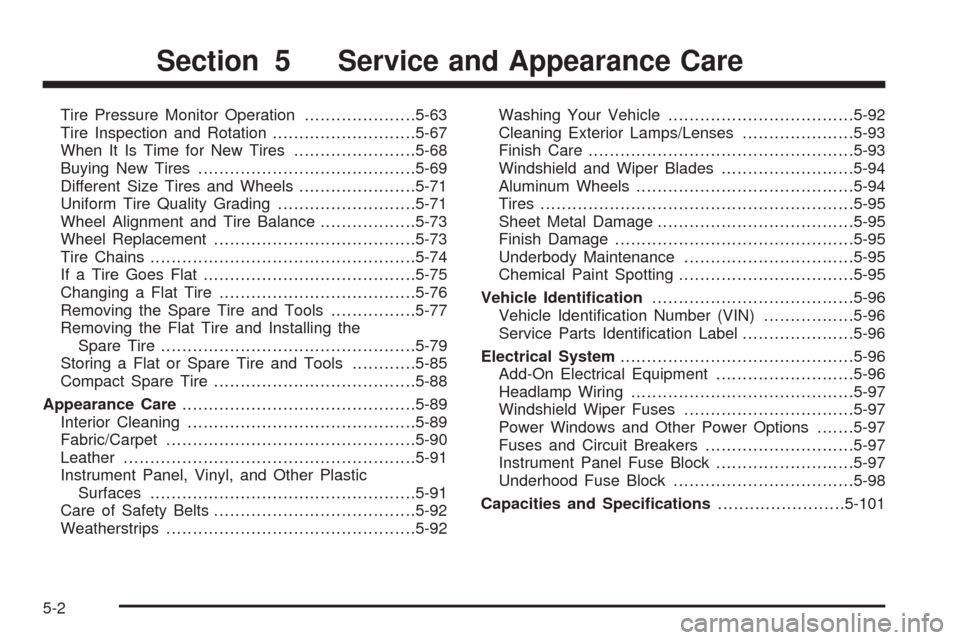
Tire Pressure Monitor Operation.....................5-63
Tire Inspection and Rotation...........................5-67
When It Is Time for New Tires.......................5-68
Buying New Tires.........................................5-69
Different Size Tires and Wheels......................5-71
Uniform Tire Quality Grading..........................5-71
Wheel Alignment and Tire Balance..................5-73
Wheel Replacement......................................5-73
Tire Chains..................................................5-74
If a Tire Goes Flat........................................5-75
Changing a Flat Tire.....................................5-76
Removing the Spare Tire and Tools................5-77
Removing the Flat Tire and Installing the
Spare Tire................................................5-79
Storing a Flat or Spare Tire and Tools............5-85
Compact Spare Tire......................................5-88
Appearance Care............................................5-89
Interior Cleaning...........................................5-89
Fabric/Carpet...............................................5-90
Leather.......................................................5-91
Instrument Panel, Vinyl, and Other Plastic
Surfaces..................................................5-91
Care of Safety Belts......................................5-92
Weatherstrips...............................................5-92Washing Your Vehicle...................................5-92
Cleaning Exterior Lamps/Lenses.....................5-93
Finish Care..................................................5-93
Windshield and Wiper Blades.........................5-94
Aluminum Wheels.........................................5-94
Tires...........................................................5-95
Sheet Metal Damage.....................................5-95
Finish Damage.............................................5-95
Underbody Maintenance................................5-95
Chemical Paint Spotting.................................5-95
Vehicle Identi�cation......................................5-96
Vehicle Identi�cation Number (VIN).................5-96
Service Parts Identi�cation Label.....................5-96
Electrical System............................................5-96
Add-On Electrical Equipment..........................5-96
Headlamp Wiring..........................................5-97
Windshield Wiper Fuses................................5-97
Power Windows and Other Power Options.......5-97
Fuses and Circuit Breakers............................5-97
Instrument Panel Fuse Block..........................5-97
Underhood Fuse Block..................................5-98
Capacities and Speci�cations........................5-101
Section 5 Service and Appearance Care
5-2
Page 285 of 406
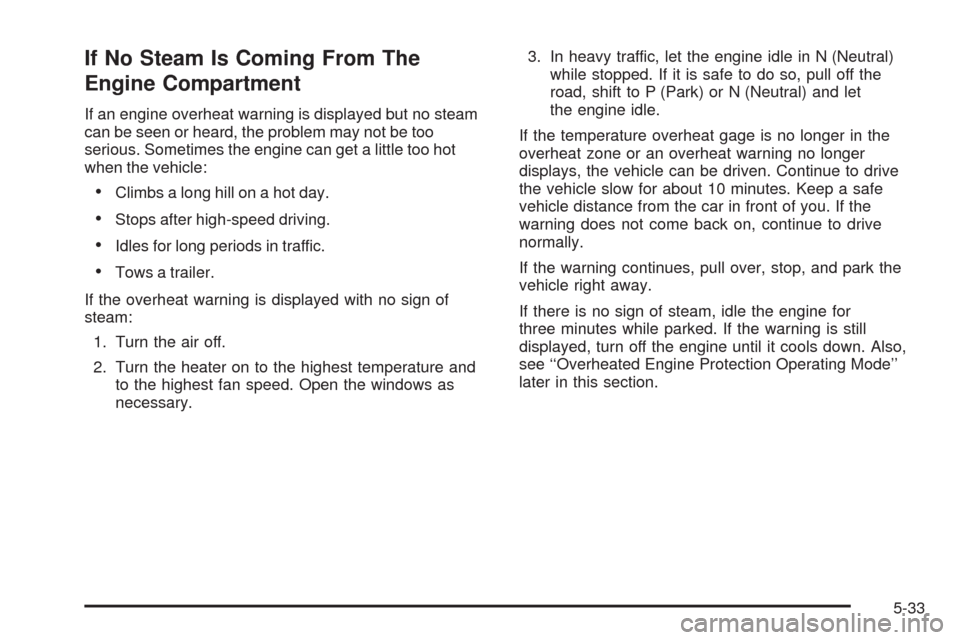
If No Steam Is Coming From The
Engine Compartment
If an engine overheat warning is displayed but no steam
can be seen or heard, the problem may not be too
serious. Sometimes the engine can get a little too hot
when the vehicle:
Climbs a long hill on a hot day.
Stops after high-speed driving.
Idles for long periods in traffic.
Tows a trailer.
If the overheat warning is displayed with no sign of
steam:
1. Turn the air off.
2. Turn the heater on to the highest temperature and
to the highest fan speed. Open the windows as
necessary.3. In heavy traffic, let the engine idle in N (Neutral)
while stopped. If it is safe to do so, pull off the
road, shift to P (Park) or N (Neutral) and let
the engine idle.
If the temperature overheat gage is no longer in the
overheat zone or an overheat warning no longer
displays, the vehicle can be driven. Continue to drive
the vehicle slow for about 10 minutes. Keep a safe
vehicle distance from the car in front of you. If the
warning does not come back on, continue to drive
normally.
If the warning continues, pull over, stop, and park the
vehicle right away.
If there is no sign of steam, idle the engine for
three minutes while parked. If the warning is still
displayed, turn off the engine until it cools down. Also,
see ‘‘Overheated Engine Protection Operating Mode’’
later in this section.
5-33
Page 309 of 406
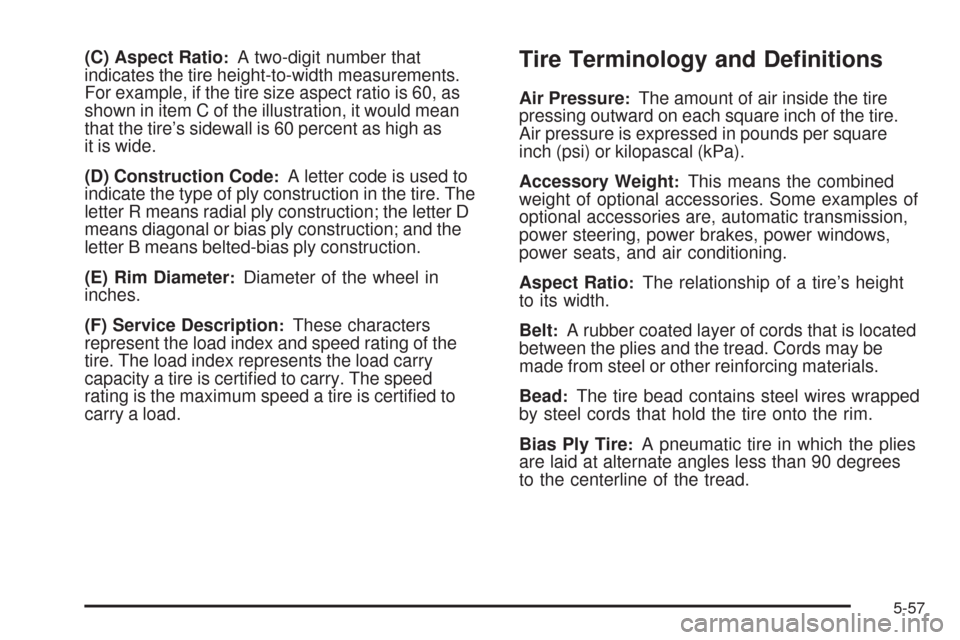
(C) Aspect Ratio:A two-digit number that
indicates the tire height-to-width measurements.
For example, if the tire size aspect ratio is 60, as
shown in item C of the illustration, it would mean
that the tire’s sidewall is 60 percent as high as
it is wide.
(D) Construction Code
:A letter code is used to
indicate the type of ply construction in the tire. The
letter R means radial ply construction; the letter D
means diagonal or bias ply construction; and the
letter B means belted-bias ply construction.
(E) Rim Diameter
:Diameter of the wheel in
inches.
(F) Service Description
:These characters
represent the load index and speed rating of the
tire. The load index represents the load carry
capacity a tire is certi�ed to carry. The speed
rating is the maximum speed a tire is certi�ed to
carry a load.
Tire Terminology and De�nitions
Air Pressure:The amount of air inside the tire
pressing outward on each square inch of the tire.
Air pressure is expressed in pounds per square
inch (psi) or kilopascal (kPa).
Accessory Weight
:This means the combined
weight of optional accessories. Some examples of
optional accessories are, automatic transmission,
power steering, power brakes, power windows,
power seats, and air conditioning.
Aspect Ratio
:The relationship of a tire’s height
to its width.
Belt
:A rubber coated layer of cords that is located
between the plies and the tread. Cords may be
made from steel or other reinforcing materials.
Bead
:The tire bead contains steel wires wrapped
by steel cords that hold the tire onto the rim.
Bias Ply Tire
:A pneumatic tire in which the plies
are laid at alternate angles less than 90 degrees
to the centerline of the tread.
5-57
Page 341 of 406

Appearance Care
Interior Cleaning
The vehicle’s interior will continue to look its best if it is
cleaned often. Although not always visible, dust and dirt
can accumulate on the upholstery. Dirt can damage
carpet, fabric, leather, and plastic surfaces. Regular
vacuuming is recommended to remove particles from the
upholstery. It is important to keep the upholstery from
becoming and remaining heavily soiled. Soils should be
removed as quickly as possible. The vehicle’s interior
may experience extremes of heat that could cause stains
to set rapidly.
Lighter colored interiors may require more frequent
cleaning. Use care because newspapers and garments
that transfer color to home furnishings may also
transfer color to the vehicle’s interior.When cleaning the vehicle’s interior, only use cleaners
speci�cally designed for the surfaces being cleaned.
Permanent damage may result from using cleaners on
surfaces for which they were not intended. Use glass
cleaner only on glass. Remove any accidental over-spray
from other surfaces immediately. To prevent over-spray,
apply cleaner directly to the cleaning cloth.
Notice:Using abrasive cleaners when cleaning
glass surfaces on the vehicle, could scratch the glass
and/or cause damage to the rear window defogger.
When cleaning the glass on the vehicle, use only a
soft cloth and glass cleaner.
Many cleaners contain solvents that may become
concentrated in the vehicle’s breathing space. Before
using cleaners, read and adhere to all safety instructions
on the label. While cleaning the vehicle’s interior,
maintain adequate ventilation by opening the vehicle’s
doors and windows.
Dust may be removed from small buttons and knobs
using a small brush with soft bristles.
5-89
Page 349 of 406
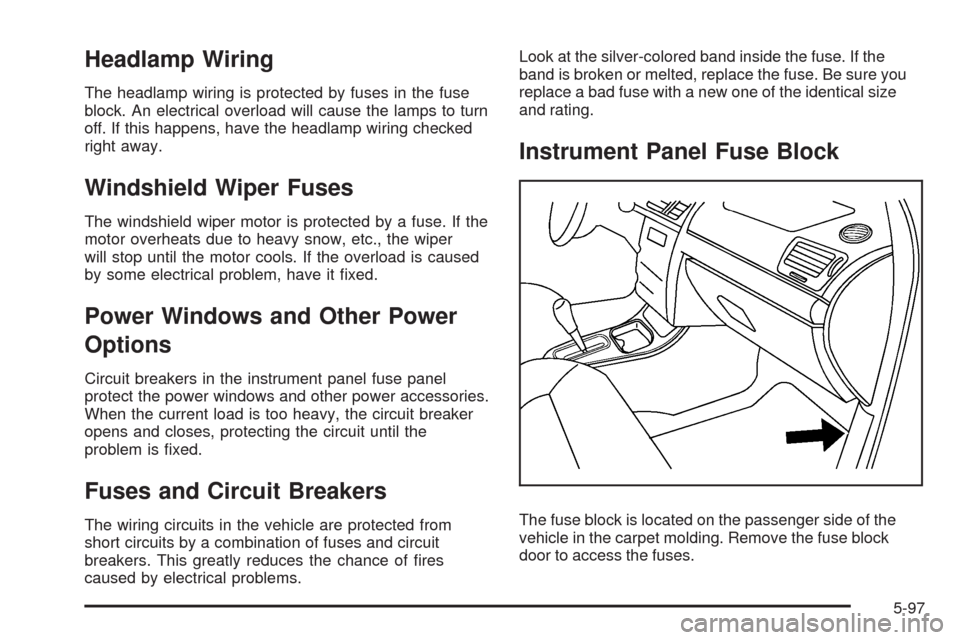
Headlamp Wiring
The headlamp wiring is protected by fuses in the fuse
block. An electrical overload will cause the lamps to turn
off. If this happens, have the headlamp wiring checked
right away.
Windshield Wiper Fuses
The windshield wiper motor is protected by a fuse. If the
motor overheats due to heavy snow, etc., the wiper
will stop until the motor cools. If the overload is caused
by some electrical problem, have it �xed.
Power Windows and Other Power
Options
Circuit breakers in the instrument panel fuse panel
protect the power windows and other power accessories.
When the current load is too heavy, the circuit breaker
opens and closes, protecting the circuit until the
problem is �xed.
Fuses and Circuit Breakers
The wiring circuits in the vehicle are protected from
short circuits by a combination of fuses and circuit
breakers. This greatly reduces the chance of �res
caused by electrical problems.Look at the silver-colored band inside the fuse. If the
band is broken or melted, replace the fuse. Be sure you
replace a bad fuse with a new one of the identical size
and rating.
Instrument Panel Fuse Block
The fuse block is located on the passenger side of the
vehicle in the carpet molding. Remove the fuse block
door to access the fuses.
5-97
Page 350 of 406

Fuses Usage
AIRBAG Airbags
AMP Ampli�er
AUX Auxiliary Outlets
CNSTR Canister
DR/LCK Door Locks
HTD/SEAT Heated Seats
Fuses Usage
PWR/MIR Power Mirrors
PWR/SEAT Power Seats
PWR/WNDW Power Window
RAP Retained Accessory Power
S/ROOF Sunroof
TRUNK Trunk
TRUNK Trunk Relay
XM XM™ Radio
Underhood Fuse Block
The underhood fuse block is located in the engine
compartment. SeeEngine Compartment Overview on
page 5-14for more information on location.
Notice:Spilling liquid on any electrical components
on the vehicle may damage it. Always keep the
covers on any electrical component.
5-98
Page 397 of 406

E
E85 Fuel......................................................... 5-8
EDR .............................................................7-18
Electrical Equipment
Add-On Equipment......................................5-96
Electrical System
Fuses and Circuit Breakers...........................5-97
Headlamp Wiring.........................................5-97
Instrument Panel Fuse Block.........................5-97
Power Windows and Other Power Options......5-97
Underhood Fuse Block.................................5-98
Windshield Wiper Fuses...............................5-97
Electronic Immobilizer
PASS-Key
®III+...........................................2-17
Electronic Immobilizer Operation
PASS-Key
®III+...........................................2-18
Electronic Stability Control................................. 4-6
Engine
Air Cleaner/Filter.........................................5-21
Check and Service Engine Soon Lamp...........3-36
Compartment Overview................................5-14
Coolant......................................................5-28
Coolant Heater............................................2-22
Coolant Temperature Gage...........................3-34
Coolant Temperature Warning Light................3-34
Cooling System...........................................5-26
Drive Belt Routing.......................................6-14
Exhaust.....................................................2-30
Oil .............................................................5-17Engine (cont.)
Oil Life System...........................................5-20
Overheated Protection Operating Mode...........5-34
Overheating................................................5-31
Starting......................................................2-21
Entry Lighting.................................................3-15
Event Data Recorders.....................................7-18
Extender, Safety Belt.......................................1-33
Exterior Lamps...............................................3-12
F
Filter
Engine Air Cleaner......................................5-21
Finish Damage...............................................5-95
Flashers, Hazard Warning.................................. 3-6
Flash-to-Pass................................................... 3-8
Flat Tire........................................................5-75
Flat Tire, Changing.........................................5-76
Flat Tire, Storing.............................................5-85
Fluid
Automatic Transmission................................5-24
Power Steering...........................................5-34
Windshield Washer......................................5-35
Fog Lamp
Fog ...........................................................3-14
Fog Lamp Light..............................................3-40
Folding Rear Seat...........................................1-10
5
Page 402 of 406
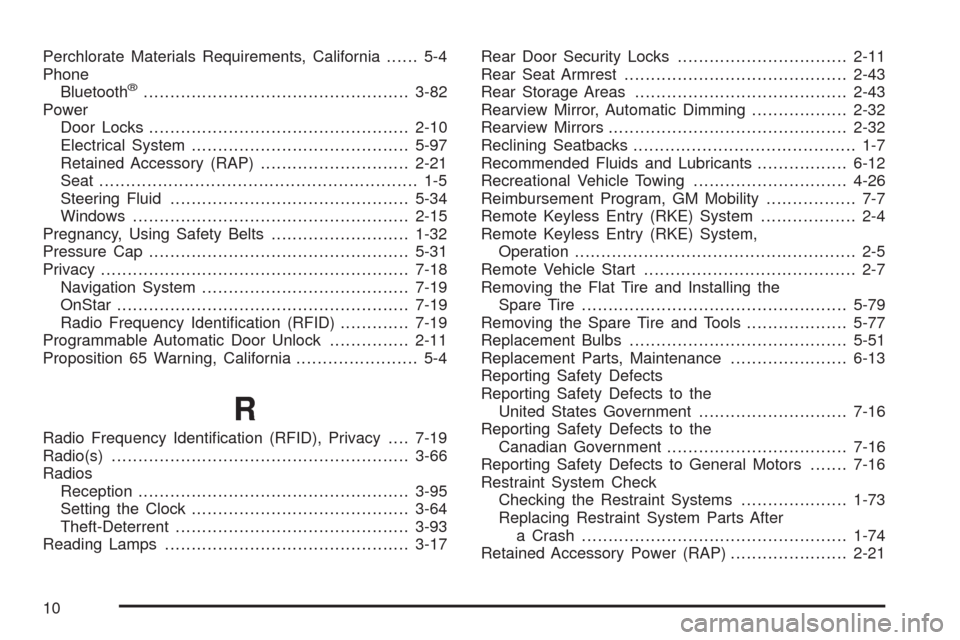
Perchlorate Materials Requirements, California...... 5-4
Phone
Bluetooth
®..................................................3-82
Power
Door Locks.................................................2-10
Electrical System.........................................5-97
Retained Accessory (RAP)............................2-21
Seat ............................................................ 1-5
Steering Fluid.............................................5-34
Windows....................................................2-15
Pregnancy, Using Safety Belts..........................1-32
Pressure Cap.................................................5-31
Privacy..........................................................7-18
Navigation System.......................................7-19
OnStar .......................................................7-19
Radio Frequency Identi�cation (RFID).............7-19
Programmable Automatic Door Unlock...............2-11
Proposition 65 Warning, California....................... 5-4
R
Radio Frequency Identi�cation (RFID), Privacy....7-19
Radio(s)........................................................3-66
Radios
Reception...................................................3-95
Setting the Clock.........................................3-64
Theft-Deterrent............................................3-93
Reading Lamps..............................................3-17Rear Door Security Locks................................2-11
Rear Seat Armrest..........................................2-43
Rear Storage Areas........................................2-43
Rearview Mirror, Automatic Dimming..................2-32
Rearview Mirrors.............................................2-32
Reclining Seatbacks.......................................... 1-7
Recommended Fluids and Lubricants.................6-12
Recreational Vehicle Towing.............................4-26
Reimbursement Program, GM Mobility................. 7-7
Remote Keyless Entry (RKE) System.................. 2-4
Remote Keyless Entry (RKE) System,
Operation..................................................... 2-5
Remote Vehicle Start........................................ 2-7
Removing the Flat Tire and Installing the
Spare Tire..................................................5-79
Removing the Spare Tire and Tools...................5-77
Replacement Bulbs.........................................5-51
Replacement Parts, Maintenance......................6-13
Reporting Safety Defects
Reporting Safety Defects to the
United States Government............................7-16
Reporting Safety Defects to the
Canadian Government..................................7-16
Reporting Safety Defects to General Motors.......7-16
Restraint System Check
Checking the Restraint Systems....................1-73
Replacing Restraint System Parts After
a Crash..................................................1-74
Retained Accessory Power (RAP)......................2-21
10